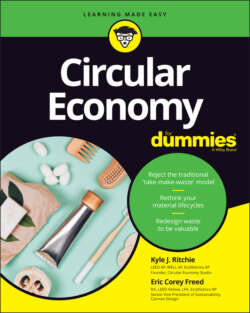Читать книгу Circular Economy For Dummies - Eric Corey Freed - Страница 82
SHAR OLIVIER SPEAKS
ОглавлениеShar Olivier, senior sustainability consultant at Vessel, an environmental services and clean energy consultancy group based in New York, has the following to say about developing a circular economy strategy:
Strategy in the circular economy creates closed loops. Currently, our economy and industry use a take-and-make linear model. Raw materials are mined and used as products and then thrown away. Waste, pollution, and resource scarcity are hallmarks of this linear model. In the circular economy, most materials enter back into either the biological or technical streams. In our work, we strive to create design thinking for the circular economy model. We use data, lifecycle assessment, and design thinking to create solutions through products and services that foster a closed loop, zero-waste strategy.
Over a decade ago, we started a disposable paper product company called Full Circle. We used post-industrial waste (sugar cane husk fibers) that were headed for the landfill or incinerator as our material. We took the ground-up fibers (also known as bagasse) and shaped them into plates and cups that could then be composted after use. We saved the material from ending up in a landfill or, worse, being burned and releasing greenhouse gases, furthering climate change. That material then became our product. By creating a zero-waste production plan, we prevented pollution and created a viable product that could then be returned to the biological stream through composting. We created an everyday product like paper plates, but instead of using virgin forest trees as fibers, we took the stalks from sugar cane, used to make sugar, and reused the spent fibers to make useful products that would then be composted. We closed the loop!
Petroleum-based plastic is an enemy of the circular economy. Only 2 percent of plastic sent to be recycled actually gets recycled. Single-use petroleum plastics clog our waterways and, by 2030, it is estimated that there will be more plastic than fish in our oceans! As part of the solution strategy for plastic, we designed disposable, compostable, plant-based plastic cutlery from vegetable starch. Potatoes and other plants that contain high levels of starch provide excellent binders needed to create sturdy, plant-based plastic cutlery. After use, instead of ending up in a landfill, our forks and spoons can be safely composted. These bionutrients go back into the stream and we closed the loop.
Another terrific example of transition strategy to the circular economy model is when a large. US-based household company that produces detergents and other solvents brands has thousands of tons of waste detergent annually, due to specs not being met for human use. The make-and-take-then-dispose linear model dictates that this soap (hundreds of thousands of tons of it!) be sent to a landfill each year. This company’s sustainable strategy team decided to cull it from the waste stream and sell it to car washes. This created millions of dollars in a new revenue stream while saving hundreds of tons of waste from the landfill. They closed the loop!
Recycling, reuse, and zero-waste streams are at the core of the circular economy model. In our consulting with large companies, universities, and government agencies, we strive to create strategies, policies, and production processes that realize our natural resources are finite. We cannot afford to use up and throw away petroleum, forests, precious metals and other resources that then create pollution, contaminate water and air, and become hazardous to wildlife and biodiversity. When we understand and embrace the circular economy strategy, scarcity, deforestation, pollution, and waste become problems of the past.
